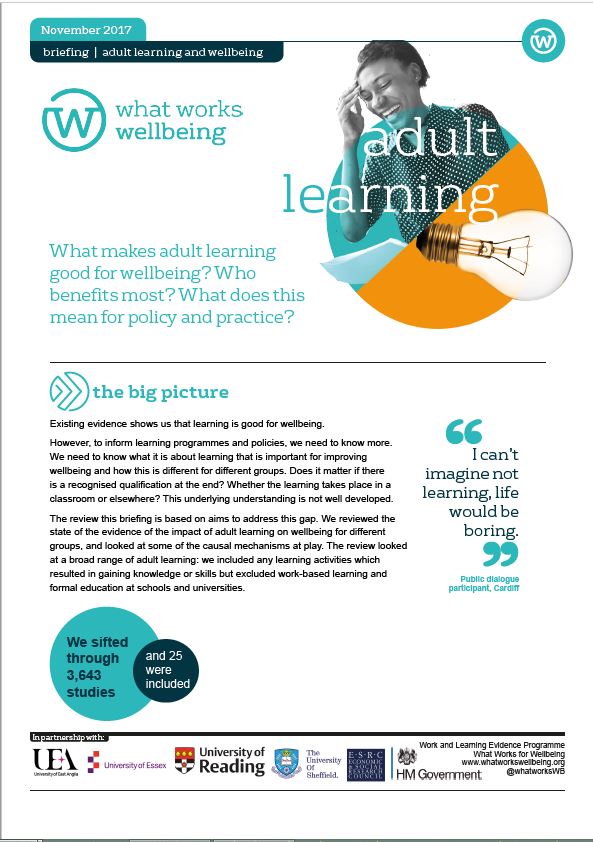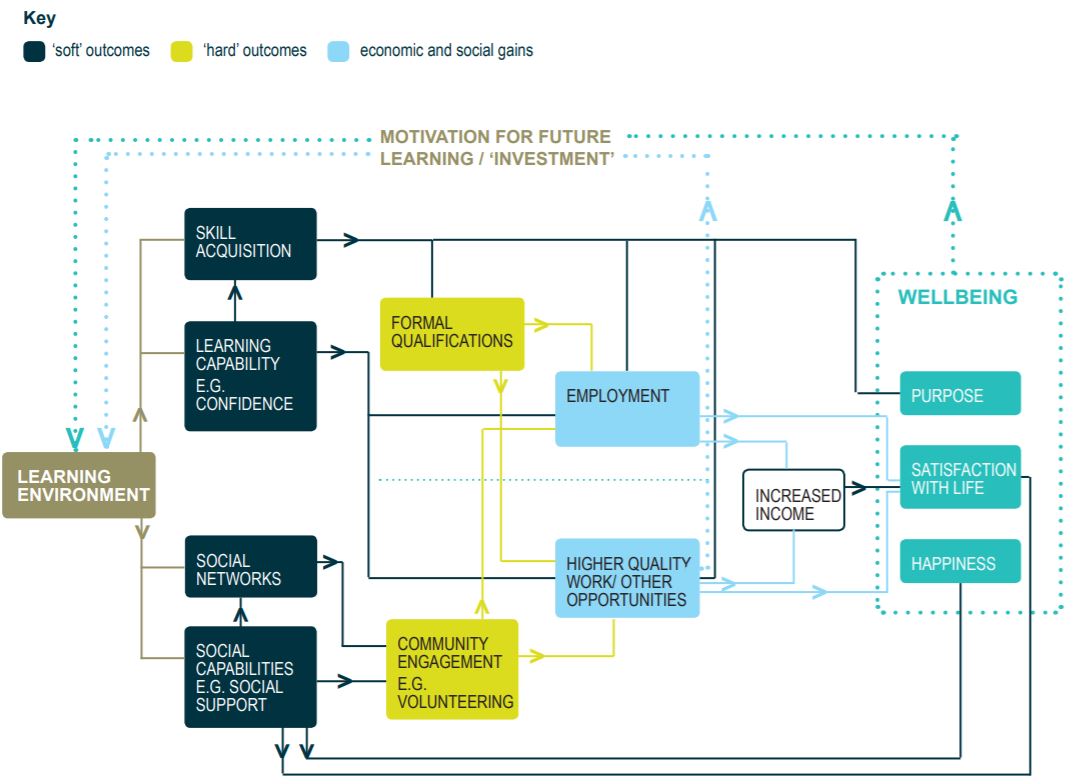Adult learning
Downloads

Intro
What makes adult learning good for wellbeing? Who benefits most? What does this mean for policy and practice?
The big picture
Existing evidence shows us that learning is good for wellbeing.
However, to inform learning programmes and policies, we need to know more. We need to know what it is about learning that is important for improving wellbeing and how this is different for different groups. Does it matter if there is a recognised qualification at the end? Whether the learning takes place in a classroom or elsewhere? This underlying understanding is not well developed.
The review this briefing is based on aims to address this gap. We reviewed the state of the evidence of the impact of adult learning on wellbeing for different groups, and looked at some of the causal mechanisms at play. The review looked at a broad range of adult learning: we included any learning activities which resulted in gaining knowledge or skills but excluded work-based learning and formal education at schools and universities.
I can’t imagine not learning, life would be boring.
- Public dialogue participant, Cardiff
-
3643
Studies sifted
-
25
Studies included
Key findings
Where you see the following symbols it indicates:
-
qualitative
-
quantitative
-
strongWe can be confident that the evidence can be used to inform decisions.
-
promisingWe have moderate confidence. Decision makers may wish to incorporate further information to inform decisions.
-
initialWe have low confidence. Decision makers may wish to incorporate further information to inform decisions.
This evidence comes from a mixture of quantitative and qualitative studies (unless explicitly stated that it is only from qualitative studies). Where a certain statement scores higher on confidence in qualitative evidence (CerQUAL) than it scores in quality on quantitative (GRADE), the lowest of both gradings is presented.
These studies supported the existing
evidence that shows learning is positive
for wellbeing.
Learning can have a range of wellbeing
benefits, including, facilitating social contact, developing purpose, and enabling progression.
Initial to strong evidence, see sections below for breakdown for different groups
Hard outcomes, such as a formal
qualification, and soft learning outcomes,
like improved self confidence or social
relations, are both important for achieving
wellbeing impacts.
Promising to strong evidence, see sections below for
breakdown for different groups
Both in terms of learners achieving learning outcomes, but also as a source of support and to foster the social benefits of learning which contribute to wellbeing.
Initial to promising evidence, see sections
below for breakdown for different groups
Pathways from learning to wellbeing

How can we turn this evidence into action?
Policy-makers and commissioners need to be aware that:
- ‘Soft’ outcomes, like confidence, self esteem, interpersonal awareness, can be as important as ‘hard’ outcomes, such as skills or formal qualifications
- Although not the focus for enquiry, this report highlighted that a number of barriers to learning still exist, especially for marginalised groups.
Learning/training providers should realise that:
- Both ‘hard’ and ‘soft’ outcomes matter for wellbeing. We need to consider how these outcomes are captured and how effectively learning is delivering both types of outcome.
- A range of different learning opportunities is important. This report highlights that the motivations and needs of different groups vary.
Researchers could consider exploring:
- What do different learners need? What is the most cost effective choice for different groups? Existing studies did not allow us to explore this in detail.
- The review brought together a range of evidence both qualitative and quantitative, but there were relatively few studies which combined them in a robust and detailed evaluation of learning interventions.
![]()
[gravityform id=1 title=true description=true ajax=true tabindex=49]






